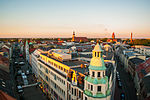Cottbus (German pronunciation: [ˈkɔtbʊs] ) or Chóśebuz (Lower Sorbian pronunciation: [ˈxɨɕɛbus]) is a university city and the second-largest city in the German state of Brandenburg after the state capital of Potsdam. With around 98,000 inhabitants, it is the most populous city in Lusatia. Cottbus lies in the Sorbian settlement area (Serbski sedleński rum) of Lower Lusatia, and is the second-largest city on the River Spree after Berlin, from which it is situated around 125 km (78 mi) upstream. The city is located on the shores of Cottbus Eastern Lake (Chóśebuski pódzajtšny jazor), which will be Germany's largest artificial lake by surface area when flooding is completed.
Cottbus is considered the political and cultural center of the Lower Sorbian-speaking Sorbs (in Lower Lusatia also called the Wends), while the overall center of all Sorbs (Lower and Upper) is Bautzen. Cottbus is the largest officially bilingual city in Germany, and the signage is mostly in German and Lower Sorbian. The city is the seat of several Lower Sorbian institutions like the Lower Sorbian version of the Sorbian Broadcasting (Serbski rozgłos/Bramborske Serbske Radijo), the Lower Sorbian Gymnasium, and the Wendish Museum (Serbski muzej). The use of the Lower Sorbian language, however, is more widespread in the surrounding villages than in the city itself. Cottbus is a major railway junction with extensive sidings/depots.
In the 10th century, the Wends constructed the largest Slavic castle of Lower Lusatia, a gord, on a Spree island, and this former gord is considered the nucleus of the city. On it rises the massive 13th century Castle Tower (grodojski torm) with its blue clock.
Cottbus is the seat of the Brandenburg University of Technology (German: Brandenburgische Technische Universität Cottbus–Senftenberg, Lower Sorbian: Bramborska techniska uniwersita Chóśebuz–Zły Komorow). Due to this, the city has the official names Universitätsstadt Cottbus/Uniwersitne město Chóśebuz (University City Cottbus). Branitz Castle, built in 1770–71, in the southeast of the city, was a residence of the Prince of Pückler-Muskau. The prince, who also created Muskau Park, designed the extensive Branitz Park on the shores of the Spree, with its two grass pyramids. Cottbus State Theater (Statne źiwadło Chóśebuz) is the only state theater in Brandenburg. The Wendish Quarter is a part of the city supposed to resemble the traditional Sorbian architectural style, constructed of prefabricated concrete slabs in East Germany between 1984 and 1989.











